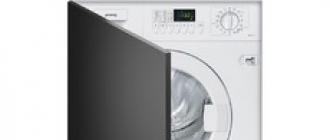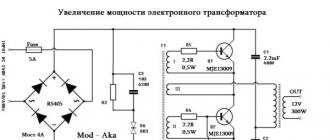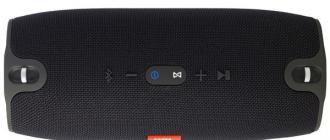
Sometimes you need to connect Android to your computer under Windows control to transfer specific files. Sometimes problems arise, and the computer does not see the phone via USB, it charges, but does not provide the ability to move files.
We propose to consider in general terms possible options and then discuss all the solutions to the problems.
Reasons why the computer does not see the phone via USB
This may be to blame software incompatibility or technical problems. From time to time, the cable is damaged, the contacts in the smartphone break. In the first case, you need to try another cord, and in the second, contact service center to replace the connector. A broken port on the computer can also be causing the problem, so switch the wire to a different socket to fix the problem. These are the most common hardware failures.
WITH software bugs more difficult, since there are a lot of reasons for failures. These may be missing or outdated drivers, incorrect connection modes (when the computer charges the smart, but blocks the transposition of documentation into folders) and other incompatibilities, which we will discuss in detail below.
What if the computer cannot see the phone?
Listed below are all the methods that can help you solve the cable connection problem.
Check your USB connection settings
The method will help if charging is in progress during pairing, but the information cannot be reset. To transfer documents, you need to connect Android as a media device (MTP). To do this, follow these steps.
Attention!In some cases, you may have to connect your phone to your computer and switch between different options several times before the desktop recognizes your device as multimedia.
If you have older versions of Android, try this.

Connect the device to your computer, it should be recognized.
Install USB MTP driver
It happens that the smartphone is not displayed due to driver problems, so try updating it.

Once the driver is installed, the PC should recognize Android phone... You may need to restart your computer for the update to take effect.
Download and Install Media Feature Pack for Windows 10
We already mentioned that you need to use the MTP protocol to transfer content. It is related to Windows Media Player and some versions of Windows 10 don't have a player Windows Media and support for related technologies. If your Windows version 10 does not recognize Android, download and install Media Feature Pack from Microsoft official website. 
Use the supplied USB cable
Uninstall Android Drivers
Sometimes the system does not latest drivers or they are not installed correctly. We recommend that you remove them and reinstall them.

It remains to check if the method worked.
Activate USB Debugging
From time to time, a connected gadget is recognized when USB debugging is active. If you are using Android 4.2 or newer, this feature may be hidden. To enable it, follow the steps below.
- Go to Settings - About Phone.
- 7 times click on "Build number".
- Go back.
- Open "Settings - For Developers".
- There, scroll down and activate "USB Debugging".
Sometimes it is already on, in which case it should be turned off.
Turn on airplane mode
If Windows has stopped seeing the phone, start Airplane mode through the panel quick settings in the blind or by going to the "Settings - More" path. Often the machine is then recognized by the PC. This is an easy way, so feel free to try it out. 
Reboot your phone in Recovery or Fastboot mode
Read about how to enter it in our other article, where we described the process for each manufacturer. After you get to Fastboot mode or recovery, connect the smartphone to the PC, wait until the necessary components are installed. After that, a conductor should open in front of you with a proposal on what to do with the connected device. When done, restart your Android. 
Install KIES from Samsung
If your Samsung gadget is not recognized by Windows, download software KIES from the manufacturer's official website and install it on your computer. With it, you can definitely connect your smartphone.
Use USB 2.0 ports
Try switching the cable from USB 3.0 to USB 2.0. Users reported that it worked sometimes for them.
Reinstall ADB
Windows occasionally does not recognize the smartphone due to problems with the Android Composite ADB interface, so you should reinstall it.

This solution works with Android 5.0 and newer OS, but it may also be compatible with older ones. Android versions... Users have reported that it is not always worth downloading the YUSB driver from Google, and often the problem is solved simply by following the first four steps.
Reboot your Android device
At times, this simple solution turns out to be the most effective. People have repeatedly reported that after restarting the phone, the computer recognized the mobile phone without any problems.
Connect your phone directly to your computer
Some USB devices may not be recognized if you connect them to a USB hub or extension cable. Therefore, if you are using a USB hub, disconnect it and connect your Android directly to your PC to fix the problem.
Clear cache and data for external system storage and storage systems
This solution works on Android 6 and up. But if you have installed more old system, try this anyway.

After deleting the cache and data, restart the gadget and reconnect it to your computer.
Sync Android to PC using a third-party app
This does not guarantee 100% performance, but it often helps. Just install the sync app from Play Market which will help the computer to recognize. Try, for example, Mobile Go for connecting and transferring data from Android and iOS to PC.
There are many reasons why a computer cannot see an Android phone. We hope these solutions are helpful to you and solve your problems.
There are many reasons why the computer does not see the smartphone. Most often this happens due to the activation of any other connection mode, except for the USB drive. Either it happens due to missing or conflicting drivers. Less commonly, the cause may be various malfunctions in the equipment.
This material presents solutions to the most common problems that arise when connecting a mobile device to a PC via USB. For convenience, all tips are categorized by importance.
Smartphone is not detected as external storage
Note:smartphone must be turned on if locked graphic key- you need to unlock!
The very first and most obvious action is to let the computer understand in which mode the device is connected. If the smartphone is simply charging when the cable is connected, it may be connected in charging mode, or as a media player. If you are using an Android device, you need to activate developer mode, and then enable USB debugging.
For instructions on activating developer mode and USB debugging, see this video.
When everything is done, at the next reconnection, pay attention to the display and the notification shade in the smartphone. A notification should appear in which you must select the "Enable USB storage" item. 
If you use a smartphone with a different OS, everything is the same. In most cases, for the device to be recognized as external storage, you must select the correct connection type.

One more point: check if the tethering mode is activated in the mobile device. Go to settings network parameters, and if the modem is activated, turn it off.

The computer does not respond at all
It is advisable to check the serviceability of the components as early as possible to save your own time. If, when connecting, you do not hear a characteristic signal, the charge indicator does not flash on the smartphone, the backlight does not activate, no pop-up notifications appear - we are trying to temporarily change the equipment.
Steps to be taken:
- Checking USB cable for serviceability. We just use a different work cable, and that's it.
- We connect to other connectors. For inoperable USB port you can refer only if no "YUSB" peripherals at all connect to them: mice, keyboards, flash drives, etc.
- We are trying to connect a smartphone via USB to another system unit or laptop. If it worked, we look for problems with the drivers and operating system on our PC.

Software problems
Let's say the computer is responding to the machine, but a notification is displayed on the taskbar that the driver installation has failed. This indicates the need to install the "correct" USB drivers on the PC.

Often universal drivers can be downloaded from the manufacturer's website. For example, the official websites of Samsung and LG have special sections where you can download a driver that will fit all Samsung and LG models, respectively.
If you have connected many devices from different manufacturers, their drivers may be conflicting. Try to remove the unnecessary ones, and reinstall the necessary ones. Do not forget to restart your PC (you can do the phone at the same time).
If nothing helps at all
In the event that after executionabsolutely all recommendations the computer does not see the smartphone, it cannot be ruled out that the USB connector on the smartphone is faulty. This problem cannot be solved independently without special skills and certain equipment. It is necessary to carry the mobile device to the service center, or to the workshop, where the USB soldering will be carried out.
Quite often, when using the Samsung Kies program, users cannot connect to the program. She simply does not see the mobile device. There can be many reasons for this problem. Let's consider what could be the case.
In Samsung Kies, there is a dedicated wizard that can fix the connection problem. This method is suitable if the computer sees the phone, but the program does not.
You need to click "Troubleshooting a connection error" and wait a while until the wizard completes its work. But as practice shows, this method rarely works.

Faulty USB connector and cable
The computer or laptop has several USB connectors... Due to their frequent use, they can break. Therefore, if Samsung Kies does not see the phone, pay attention to whether the computer itself can see it.
To do this, you need to unplug the cord from the device and plug it back in. A window with the connection status should be displayed in the lower right corner. If this is not the case, then reconnect the phone through a different connector.
Also, the problem may be a cable malfunction. If you have a spare, try connecting through it ..
Virus check
Situations are not uncommon when access to various devices blocked by malware.
Spend full check your antivirus program.

For reliability, check your computer with one of the special utilities:,. They can scan your computer without stopping the main antivirus.

Drivers
Connectivity issue may be caused by old drivers or missing drivers.
To solve the problem, you need to go to "Device Manager", find your phone in the list. Next, click on the device right click mouse and select "Update driver".

If there is no driver, download it from the official site and install it.
Wrong choice of program version
On the website of the manufacturer of the program Samsung Kies, three versions are provided for download. Look closely at the ones for Windows. The brackets indicate which version should be selected for a particular model.
If the choice was made incorrectly, the program must be uninstalled, downloaded and installed the appropriate version.

As a rule, after all the actions done, the problem disappears and the phone successfully connects to the program.
Most owners of Samsung mobile devices use Samsung app Kies. But it often happens that the computer does not see the phone. Where to look for the cause of the malfunction and how can it be corrected?
Computer does not see my Samsung phone
If your PC doesn't recognize your device as a connected device, don't be discouraged right away. Perhaps the USB ports are out of order - try, as an option, to connect to another computer. Update system drivers and scan your operating system for viruses.

If the PC recognizes the connected device, then problems should be looked for in the settings of the mobile gadget or application.
Samsung Kies can't see my phone
So, operating system recognizes your device, but the Kies app insists that nothing is connected. First of all, pull the USB cable out of the device and close the program. Then reconnect the gadget to the PC (as an option, you can select a different USB port, and do not use extension cords) and try to launch the Kies application until the icon of the connected device appears.

A common reason why Samsung Kies does not see the phone is hidden in your settings mobile device... Go to the menu item "PC connection" and put a mark on the Kies application there. It is also worth selecting the "USB Debugging" option in the "Connection" menu item. If it does not help again, then restart the device in case of a system failure - in many cases this was an unexpected solution to this problem.
If even now Samsung Kies does not see the phone, then you need to uninstall and reinstall the drivers of the mobile device. To do this, click "Start" - "Control Panel" - "Device Manager" - " Mobile device", Right-click on the entry, select" Properties "and in the window that appears, press the" Delete "button. Restart your computer and then install official drivers from the manufacturer for your gadget. Then try connecting again.

If the method above does not work, and the phone still does not connect to Kies, reinstall the application itself. Maybe there were errors during installation, there was system failure during the last session or you just old version applications. Click "Start", then "Add or Remove Programs" (this menu item in Windows 7 is called "Programs and Features"), remove the Kies application. After completing this procedure, you need to clean the registry from possible "traces". For these purposes, it is better to use the capabilities of programs specializing in cleaning the registry (for example, CC Cleaner).
After cleaning the registry, restart your computer and reinstall the program. You can download the latest, most up-to-date version of the application on the official website of the manufacturer. Disable your firewall and antivirus before starting the installation process. Do not forget that the application should be installed from under account with administrator rights.
Also, the reason why Kies does not see the phone may be a file with an incorrect length extension contained in the device's memory. The device tries to read all available files, and a software failure often occurs on such extensions, which ultimately leads to connection errors.
Remove the memory card and connect the device to the PC. If it helps, then the problem is in the removable media. Otherwise, set "Connect as a USB flash drive" in the device settings, connect it to a PC and copy required files... Then you can return them back at any time.

There are many reasons why the PC does not see Samsung phone... Try all of the above options, and only then call a specialist.
 How the web design process works
How the web design process works


Do you want to know how to earn 50 thousand monthly on the Internet?
Watch my video interview with Igor Krestinin
=>>
Connecting a Samsung phone to a computer through does not always happen successfully. Sometimes the computer does not recognize the device, does not read it internal memory and does not open folders (but charging is still in progress).
The problem can be caused by hardware or software. But regardless of this, the first step in resolving the situation will be to reboot both contacting devices. In some cases, this is enough, the contents of the smartphone are viewed from the PC again.

The reasons for this group are related to mechanical moments:
- Damaged USB cable.
One of the most common justifications for the inability to connect the phone to. A cable from an unverified manufacturer serves little, with active use - no longer than a couple of months, and then it wears out.
But a high-quality conductor may also be unsuitable for use if it is touched by a cutting object, gnawed by an animal, and so on. To check for damage to the cable, you need to connect the phone to another PC through it. If the phone is not recognized again, then the element will have to be replaced.
- Damage to the computer USB port.
The cable port may also be defective. This includes a broken USB controller and a damaged south bridge on the motherboard. Correcting the situation, they try to use a different connector. If the move turns out to be ineffective, then something else is at the root of the problem.
- Damage to the telephone jack for connection.
If water gets into the connector, as well as after impacts or scratches, the socket may turn out to be completely dysfunctional and it will need to be completely replaced.
- Battery problems.
You need to remove the battery, insert it back and reconnect the device to the computer.
Software reasons
If the above options do not fit your situation, then you can think about software dysfunctions of the devices:
- Settings.
With the help of the settings, it is necessary to put a check mark in the section "USB connection to a computer" so that the phone is perceived by the PC as a "Media device" (" USB stick"). Also, at the time of connecting to a computer, the lock must be unlocked from the smartphone.

Non-working or not updated drivers no longer correctly show the connection status via the USB port. These programs can be restored using the source disk or the resources of the site of the organization that manufactures the motherboard.
This also includes those cases when for latest models phone need some special programs, but they can also be obtained from the respective sites.
- Unreliable operating system.
The issue is resolved only by changing the existing OS to a working one.
- Unreliability of custom (modified) firmware.
Individual users make the firmware for phones on their own, this may be the reason that the computer does not see the Samsung phone via USB. It remains only to return to the standard version of the firmware.
- Viruses.
An ordinary option, and the problem disappears after using an antivirus followed by a system reboot.
Conclusion
If the above methods are not useful, then you can take a risk and reset the settings. But remember that as a result, the device will lose everything that fills the internal memory of the phone, so you cannot use this method without a reason.






